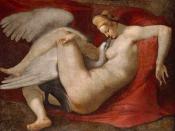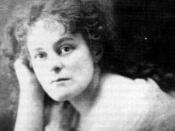Analyse William Butler Yeats's "Leda and the swan", paying particular attention to the poem's argument, but also focusing on the way meaning is conveyed and modified by rhyme scheme, meter, rhyme and stanzaic form. In the course of your discussion of this text, you must discuss what extent the texts genre has affected your analysis, given your knowledge of that genre's conventions and history. 1500 words max
W.B. Yeat's mythological poem "Leda and the swan" can be seen as a typical sonnet, recounting the rape of Leda, the wife of King of Sparta by the Greek God, Jupiter, who transformed himself in the form of a swan, named Zeus. Although merely recapping one of the many mythologies, the poem is highly metaphorical, at the same time poem had acted as a catalyst for conveying his thoughts and fantasies, subsequent to his own experience of unrequited love.
Throughout the poem, Yeats had also unveiled the context of his homeland through the period of 1922-1923 during the time of the Irish civil war, a time of aggression and uncertainty, despite the irony of the poem written in the form of a typical love sonnet. These ideas were further enhanced through the use of a large variety of poetic techniques.
Born in Dublin in 1865, William Butler Yeats spent much of his time moving from London the countryside of County Sligo, Ireland, where his grandparents had lived. Four years after publishing his first work in 1885, he fell in love with Irish patriot Maud Gonne. Although his love was unrequited, it is believed that the writer's entire collection of works can be linked back to this one and only love. "Leda and the swan" had illustrated his fantasy and the contradicting truth, as Shaw agrees the...


